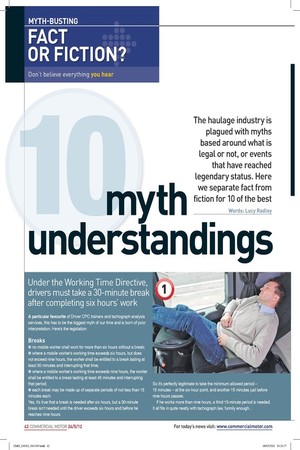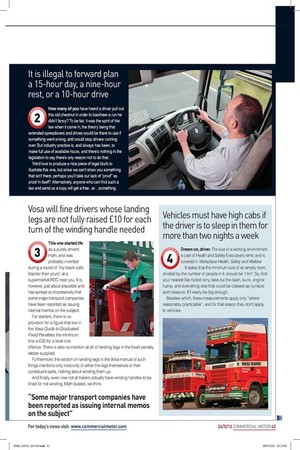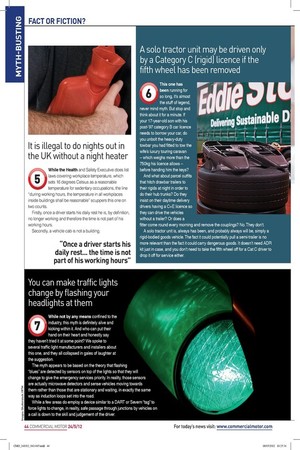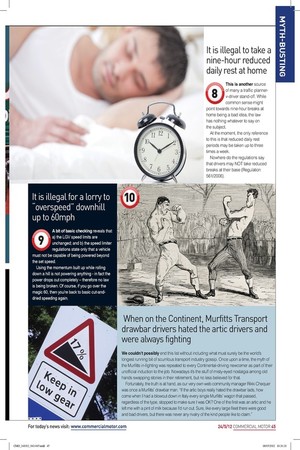yth understandings
Page 33

Page 34

Page 35

Page 36

If you've noticed an error in this article please click here to report it so we can fix it.
Under the Working Time Directive, drivers must take a 30-minute break after completing six hours’ work
A particular favourite of Driver CPC trainers and tachograph analysis services, this has to be the biggest myth of our time and is born of poor interpretation. Here’s the legislation:
Breaks
• no mobile worker shall work for more than six hours without a break; • where a mobile worker’s working time exceeds six hours, but does not exceed nine hours, the worker shall be entitled to a break lasting at least 30 minutes and interrupting that time; • where a mobile worker’s working time exceeds nine hours, the worker shall be entitled to a break lasting at least 45 minutes and interrupting that period; • each break may be made up of separate periods of not less than 15 minutes each.
Yes, it’s true that a break is needed after six hours, but a 30-minute break isn’t needed until the driver exceeds six hours and before he reaches nine hours. So it’s perfectly legitimate to take the minimum allowed period – 15 minutes – at the six-hour point, and another 15 minutes just before nine hours passes.
If he works more than nine hours, a third 15-minute period is needed. It all fits in quite neatly with tachograph law, funnily enough...
It is illegal to forward plan a 15-hour day, a nine-hour rest, or a 10-hour drive
How many of you have heard a driver pull out this old chestnut in order to backheel a run he didn’t fancy? To be fair, it was the spirit of the law when it came in; the theory being that extended spreadovers and drives would be there to use if something went wrong, and would stop drivers running over. But industry practice is, and always has been, to make full use of available hours, and there’s nothing in the legislation to say there’s any reason not to do that.
We’d love to produce a nice piece of legal blurb to illustrate this one, but since we can’t show you something that isn’t there, perhaps you’ll take our lack of “proof” as proof in itself? Alternatively, anyone who can find such a law and send us a copy will get a free...er....something.
2
Vosa will fine drivers whose landing legs are not fully raised £10 for each turn of the winding handle needed
This one started life as a purely drivers’ myth, and was probably invented during a round of “my black cat’s blacker than yours” at a supermarket RDC near you. It is, however, just about plausible and has spread so impressively that some major transport companies have been reported as issuing internal memos on the subject.
3
For starters, there is no provision for a figure that low in the Vosa Guide to Graduated Fixed Penalties; the minimum fine is £30 for a level one offence. There is also no mention at all of landing legs in the fixed penalty tables supplied.
Furthermore, the section on landing legs in the Vosa manual of such things mentions only insecurity of either the legs themselves or their constituent parts, nothing about winding them up.
And finally, even now not all trailers actually have winding handles to be fined for not winding. Myth busted, we think.
Vehicles must have high cabs if the driver is to sleep in them for more than two nights a week
Dream on, driver. The size of a working environment
4 is part of Health and Safety Executive’s remit, and is covered in Workplace Health, Safety and Welfare. It states that the minimum size of an empty room, divided by the number of people in it, should be 11m3. So, find your nearest flat-roofed lorry, take out the dash, bunk, engine hump, and everything else that could be classed as furniture and measure. It’ll easily be big enough.
Besides which, these measurements apply only “where reasonably practicable”, and for that reason they don’t apply to vehicles.
It is illegal to do nights out in the UK without a night heater
While the Health and Safety Executive does list laws covering workplace temperature, which sets 16 degrees Celsius as a reasonable temperature for sedentary occupations, the line “during working hours, the temperature in all workplaces inside buildings shall be reasonable” scuppers this one on two counts.
5
Firstly, once a driver starts his daily rest he is, by definition, no longer working and therefore the time is not part of his working hours.
Secondly, a vehicle cab is not a building.
A solo tractor unit may be driven only by a Category C (rigid) licence if the fifth wheel has been removed
This one has
been running for so long, it’s almost
the stuff of legend, never mind myth. But stop and think about it for a minute. If your 17-year-old son with his
post-’97 category B car licence
needs to borrow your car, do you unbolt the heavy-duty towbar you had fitted to tow the
wife’s luxury touring caravan – which weighs more than the 750kg his licence allows –
before handing him the keys?
And what about parcel outfits that hitch drawbar trailers to their rigids at night in order to do their hub trunks? Do they insist on their daytime delivery drivers having a C+E licence so they can drive the vehicles without a trailer? Or does a
fitter come round every morning and remove the couplings? No. They don’t.
A solo tractor unit is, always has been, and probably always will be, simply a rigid-bodied goods vehicle. The fact it could potentially pull a semi-trailer is no
more relevant than the fact it could carry dangerous goods. It doesn’t need ADR kit just in case, and you don’t need to take the fifth wheel off for a Cat C driver to
drop it off for service either.
You can make traffic lights change by flashing your headlights at them
While not by any means confined to the
industry, this myth is definitely alive and kicking within it. And who can put their hand on their heart and honestly say
they haven’t tried it at some point? We spoke to
several traffic light manufacturers and installers about this one, and they all collapsed in gales of laughter at the suggestion.
The myth appears to be based on the theory that flashing
“blues” are detected by sensors on top of the lights so that they will
change to give the emergency services priority. In reality, those sensors are actually microwave detectors and sense vehicles moving towards them rather than those that are stationary and waiting, in exactly the same way as induction loops set into the road.
While a few areas do employ a device similar to a DART or Severn “tag” to
force lights to change, in reality, safe passage through junctions by vehicles on a call is down to the skill and judgement of the driver.
It is illegal to take a nine-hour reduced daily rest at home
This is another source of many a traffic plannerv-driver stand-off. While common sense might point towards nine-hour breaks at home being a bad idea, the law has nothing whatever to say on the subject.
At the moment, the only reference to this is that reduced daily rest periods may be taken up to three times a week.
8
Nowhere do the regulations say that drivers may NOT take reduced breaks at their base (Regulation 561/2006).
It is illegal for a lorry to Adoverspeed” downhill up to 60mph
A bit of basic checking reveals that a) the LGV speed limits are unchanged; and b) the speed limiter regulations state only that a vehicle must not be capable of being powered beyond the set speed.
Using the momentum built up while rolling down a hill is not powering anything in fact the power drops out completely – therefore no law is being broken. Of course, if you go over the magic 60, then you’re back to basic cut-anddried speeding again.
When on the Continent, Murfitts Transport drawbar drivers hated the artic drivers and were always fighting
We couldn’t possibly end this list without including what must surely be the world’s longest running bit of scurrilous transport industry gossip. Once upon a time, the myth of the Murfitts in-fighting was repeated to every Continental-driving newcomer as part of their unofficial induction to the job. Nowadays it’s the stuff of misty-eyed nostalgia among old hands swapping stories in their retirement, but no less believed for that.
Fortunately, the truth is at hand, as our very own web community manager Rikki Chequer was once a Murfitts’ drawbar man. “If the artic boys really hated the drawbar lads, how come when I had a blowout down in Italy every single Murfitts’ wagon that passed, regardless of the type, stopped to make sure I was OK? One of the first was an artic and he left me with a pint of milk because I’d run out. Sure, like every large fleet there were good and bad drivers, but there was never any rivalry of the kind people like to claim.”










































